La «piedra de los juramentos», un tesoro de la arqueología griega, es trasladada de Atenas a Kassel por grupos, colectivos e individuos más o menos organizados. En Kassel, la piedra es exhibida en Documenta 14 junto con fotos del recorrido, un mapa de las Rutas de la guerra (España, 1938) y otros documentos. Al finalizar la Documenta la piedra no fue enterrada en el Thingplatz cercano, tal y como se había planeado, sino que fue subastada en e-bay. (Descargar aquí el comunicado de prensa).

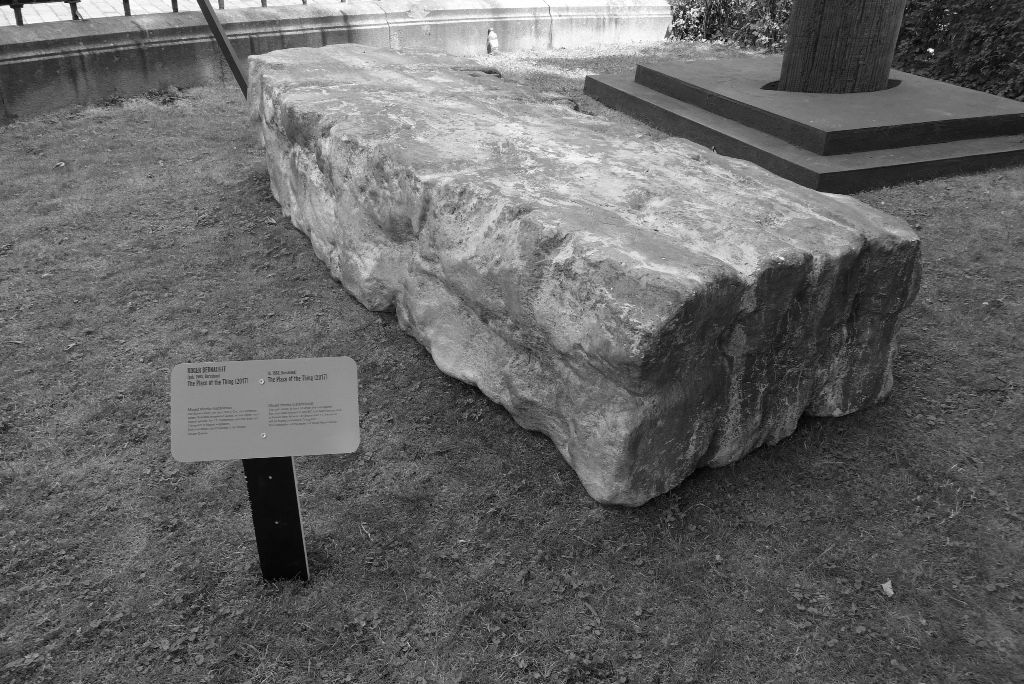
El vídeo que hay más arriba pertenece a la instalación que se mostró en la Neue Neue Gallerie de Kassel durante el verano de 2017. Este proyecto fue encargado por Paul Preciado y Adam Szymczyk para la Documenta 14. Las fotos son de Karol Jarek.
VADEMÉCUM por Roberto Fratini
- El Thingspiel es la forma más extrema de teatro de masas concebido por el régimen nazi.
- De cara a la realización de este teatro de masas para las masas el régimen nazi mandó construir por todo el territorio del Reich diferentes ejemplares de Thingplatz que eran amplias áreas al aire libre delimitadas por una grada semicircular. Este teatro es la inspiración de una estética muy parecida a la de las ceremonias de inauguración de los Juegos Olímpicos de nuestros días.
- El Thingplatz de la era nazi vuelve a proponer por un lado la estructura del Thingplatz primitivo, como lugar de reunión, consulta y celebración de los antiguos guerreros germanos (normalmente un claro del bosque marcado por un círculo de piedras) y por otro los anfiteatros griegos.
- Los Thingplatz que sobrevivieron a la desnazificación son todavía visibles en Alemania y están dirigidos a la celebración de eventos multitudinarios. El Waldbühne de Berlín, por ejemplo, con cabida para 21.000 personas, es usado para la realización de conciertos pop.
- El Thingspiel es el espectáculo teatral que se desarrolla en los Thingplatz. La colectividad involucrada en dichos espectáculos es una comunidad de pueblo llamada a tener la experiencia directa de una «epopeya vivida» en la que se celebra activamente, a través de los movimientos corales, de la organización rítmica y de las configuraciones masivas, el mito de su identidad nacional y/o racial.
- En el Thingspiel, como forma tóxica de teatro participativo, el público es pensado a la vez como autor, intérprete y espectador de su propia ficción real.
- El Thingspiel constituye un dispositivo auto-hipnótico para colectividades dispuestas a escenificarse en la vivencia mística de unos valores colectivos que ya no necesitan ser negociados o discutidos porque su encarnación activa en el cuerpo multitudinario de la masa los justifica y ratifica a priori.
- El Thingspiel, que es donde se pretende otorgar a la comunidad de pueblo la autoría directa de su propia verdad, es al mismo tiempo el dispositivo más eficaz para producir la versión más ficcional, la manipulación más extrema –cuando no la extinción– de toda autoría efectiva, de toda conciencia crítica, de toda presencia dialéctica. Es el dispositivo, en suma, en el que con más energía la colectividad celebra ser desposeída de toda posibilidad de ser un sujeto político real.
- La estética y la semántica del Thingspiel repercuten en un amplio espectro de «performances de la participación masiva e identitaria» cuyo eje más significativo sigue siendo el alistamiento del cuerpo colectivo a la maniobra del consenso generalizado y la aclamación incondicional. Hoy día, en el despliegue definitivo del capitalismo espectacular, el Thingspiel nazi se convierte en una pálida profecía de todas las formas de «gimnasia del consenso» que el siglo XXI reservaba a las masas de consumidores, basadas todas ellas en un solapamiento estratégico de lo político, lo cultural y lo religioso. Las solemnidades fúnebres, los reenactments, los deportes colectivos de estado, las liturgias culturales, las místicas del fitness y las redes sociales son algunos ejemplos.
- Es importante recordar que la raíz de la palabra germana Thing representa también el origen del inglés thing, que indica genéricamente la cosa en cuanto objeto esencial de intercambio: la cosa como expresión de una cosalidad indeterminada; la cosa como expresión física y concreta de un algo siempre pasible de ser recalificado, renombrado, refetichizado, y por ende adorado, celebrado, venerado, idolatrado. A este síndrome –de una materialidad fantasmal sujeta a desplazamientos, que existe solo como pretexto de infinitas movilizaciones del colectivo consensual– atañe un amplio abanico de objetos posibles: del falo (objeto de cultos específicos antes de convertirse en el verdadero eje de la somática fascista) al monumento o a la mercancía rasa. En este aspecto, la materialidad que ocupa el centro del Thingspiel y de todos sus sucedáneos posmodernos, es técnicamente cadavérica.
- El resultado es que el movimiento realizado por la colectividad con tal de desplazar (física y semánticamente) el objeto que ocupa el centro de la turbulencia representada por el Thingspiel, es siempre y solamente un falso movimiento.
- El proyecto de Roger Bernat/ FFF para la Documenta 14 puede resumirse de la forma siguiente: un mármol falso (y por ende la falsificación de un trozo de patrimonio arqueológico griego) es enviado de Atenas a Kassel. Ofrenda diplomática? Mercancía arqueológica? Pieza de arte contemporáneo? Monumento? Cadáver? Pago de impuestos a la Comunidad Internacional? Producto típico? Evidencia forense? La colectividad existente o advenediza acepta ocuparse físicamente del viaje de la piedra hacia Kassel –es decir del viaje que convertirá la copia inexpresiva de un inexpresivo trozo de piedra en un imán de atención cultural en el evento cultural del lustro– y acepta por tanto ocuparse también de este segundo aspecto de su transmigración, que es simbólico, porque se refiere a las «ficciones de valor» (cultural, religioso, memorial, nostálgico, fúnebre, comercial, etc.) de las que la piedra consigue cargarse a través de la movilización de la colectividad a su alrededor.
- El proyecto se fundamenta por ende en un pacto ficcional con el colectivo que, al auto-organizarse, organiza la teatralización del objeto que mueve o en cuyo derredor se mueve; que acepta en suma celebrar alrededor de la piedra un sucedáneo de Thingspiel suficientemente conspiratorio como para configurar un verdadero antiThingspiel. Si el primero fomentaba la ciega participación de los ciudadanos en una ficción que se pretendía verdadera, el segundo invitará a producir de forma dialéctica una verdad que se sabe ficcional. A elaborar en suma, alrededor del «monolito», una verdad multifacética, un misticismo tan dudoso, que será inevitable reconfigurarlo como una forma compartida (y por eso extraordinariamente compleja) de ironía política.
- Cada uno de los participantes concertará la dramaturgia específica de su propia ironía. Porque la ironía de su movilización depende de los valores o de las reivindicaciones que quiera inscribir en la piedra.
- Para que esta inscripción resulte teatral, es preciso que se mantenga intacto el optimismo propio del Thingspiel: la piedra solo es pretexto de buenas intenciones. Las peores intenciones, los programas más polémicos, las negatividades, deberían negociarse a través de la ficción positiva construida por el colectivo. El Thingspiel, debe recordarse, es una variación en la tradición alemana del Festspiel: el espectáculo como liturgia, ceremonia y celebración de los valores del pueblo.
- Los responsables del proyecto lo asumen como un cuestionamiento dialéctico de la noción de éxito. Consideran en suma que, en el marco de su dispositivo de participación, la indiferencia, la negativa a participar, incluso la no-participación son productoras de sentido tanto como la auto-movilización del colectivo «motivado». El fracaso del proyecto en sí o para sí sería un éxito absoluto, poética e ideológicamente, en relación al proyecto-para-Documenta. El fracaso es parte del estado de gracia que es la misión, la inscripción, el viaje oficial, el paseo urbano, la excursión balcánica, la huida, la parranda, la procesión, la deambulación, la deriva, el destierro, la emigración, la deportación, la desgracia de este simulacro de piedra griega.
- La piedra no llega a Kassel cargada de verdades o historias. Llega a Kassel cargada de mitos y cuentos, de fantasmas y mentiras. No es ni documento ni monumento: es, si acaso, nocumento. Barco fantasma, caballo de Troya, caramelo envenenado. Nocividad indocumentable.
- Sería un error imaginar el proyecto como un encuentro sincero entre artistas, colectivos o individuos, todos impulsados por un benévolo apego a la verdad. Si así fuera, Documenta se ocuparía simplemente de documentar la edificante eclosión de un intercambio de verdades. Es más correcto pensarlo como una juerga indefinida entre artistas, colectivos o individuos impulsados por un amor cínico a la broma reveladora, a la simulación medio verídica, al mot d’esprit y a la verdad impura, que solo producen documentos bastardos, impresentables, inservibles, ambivalentes. La piedra entretiene una relación muy vaga (o muy vagabunda) con la poética documental del marco artístico y curatorial en el que se perpetran sus excursiones físicas y simbólicas.
- El riesgo estructural al que se exponía la Documenta 14 al re-crearse entre los traumas económicos y sociales de Grecia, era avalar la ideología por la que los pobres de todo son ricos en verdades; y que tales verdades pueden consumirse de la forma –moral y culturalmente balsámica– del documento, que viene a ser el formato de arte más pobre de entre las artes pobres dedicadas a los artistas pobres: una confesión hecha arte confesional.
- Se reivindica el derecho absoluto de los pobres a mentir.


LA PIEDRA
Aunque su parte superior es lisa, la piedra no está trabajada, una condición apropiada a su función sagrada. La piedra se encuentra frente a la Stoa real y es la piedra sobre la que los magistrados tomaban juramento.
Los acontecimientos frente a la Stoa condujeron al juicio y muerte de Sócrates en el 399 a.C. El filósofo fue juzgado por impiedad, por importar nuevos dioses a la ciudad y por corromper a la juventud de Atenas. Éstos eran asuntos religiosos y como tales cayó bajo la jurisdicción del arconte rey. Los argumentos preliminares fueron sostenidos en la Stoa real, como sabemos por Platón, citando a Sócrates: «Ahora debo presentarme en la Stoa del Basileo para responder de la acusación que Meletos ha formulado contra mí» (Theatetos 201D)
Además, varios textos antiguos se refieren a la gran piedra no trabajada (lithos) encontrada frente al edificio, que fue utilizada por el arconte rey cuando, como jefe de los magistrados religiosos, hizo su juramento: «Tomaron juramento cerca de la Stoa real, sobre la piedra sobre la cual estaban los restos de las víctimas (sacrificales), jurando que guardarían las leyes» (Pollux 8.86) y «el Consejo juró conjuntamente ratificar las leyes de Solón, cada uno de ellos juró por separado en la piedra del Ágora» (Plutarco, Vida de Solón 25.2).
Escuela Americana de Estudios Clásicos
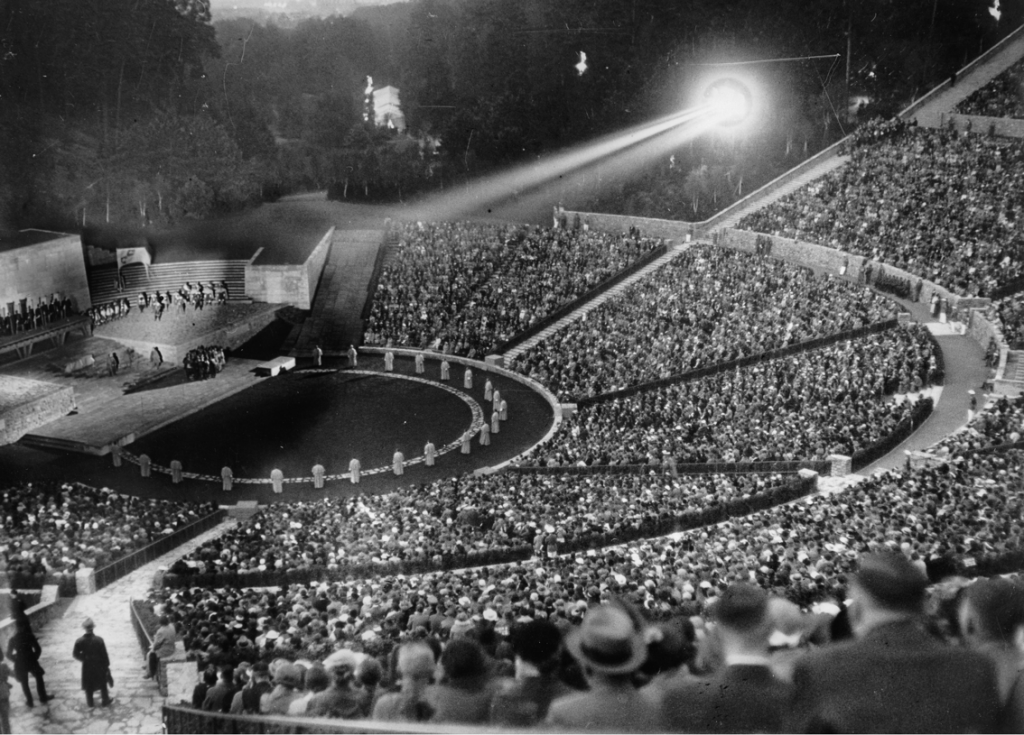
EL THINGPLATZ NAZI
El dos de agosto del 36, durante los Juegos Olímpicos de Berlín, se puso en escena en un Thingplatz construido a las afueras de la ciudad, Das Frankenburger Würfelspiel de Eberhard Wolfgang Möller. El Thingspiel fue un teatro multidisciplinar que gozó de cierta popularidad durante los años 30. Estos teatros, de los que se llegaron a construir 40 en toda Alemania, estaban formalmente inspirados en los anfiteatros griegos y conmemorar los Thing germanos, círculo de piedras sobre el que los notables de cada tribu decidían sus asuntos. En las afueras de Kassel, en el bosque de Wolfhagen, hay un cartel que atestigua la presencia de uno de estos yacimientos arqueológicos del medievo. La piedra de los juramentos será enterrada allí.

EL THINGPLATZ HISTÓRICO
Thingplatz histórico en Landau (Wolfhagen) a 38 km. de Kassel.
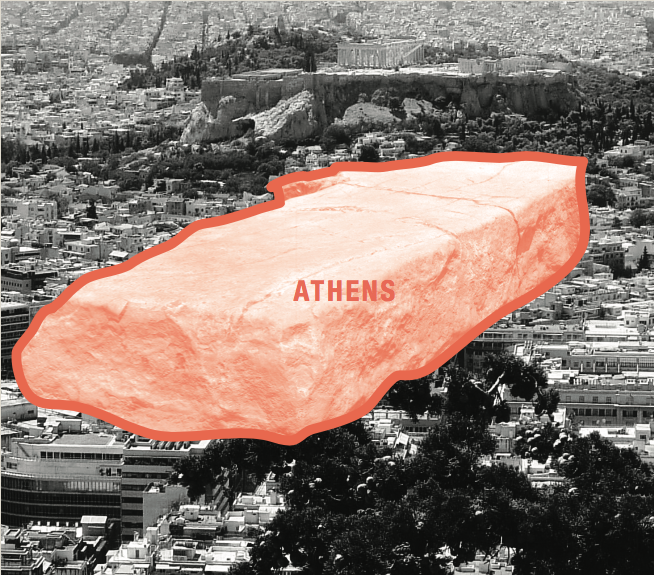
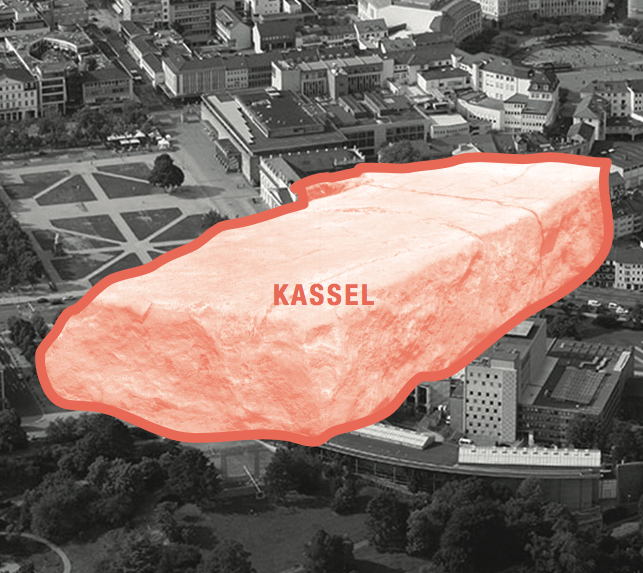
EL EQUIPO
THE PLACE OF THE THING es un proyecto de Roger Bernat que no hubiera sido posible sin la colaboración de muchas de las personas que nos recibieron en Atenas. La dramaturgia del proyecto es de Roberto Fratini. Las fotografías de Karol Jarek. La escenografía es de Freddy Gizas. El diseño gráfico de Ifigenia Vasiliou.
En Atenas han realizado la producción de la pieza Hibai Arbide. La coordinación desde Barcelona fue de Helena Febrés.
Con el apoyo de: Documenta14, CatalanArts (Generalitat de Catalunya_Departament de Cultura) y l’Institut Ramon Llull.
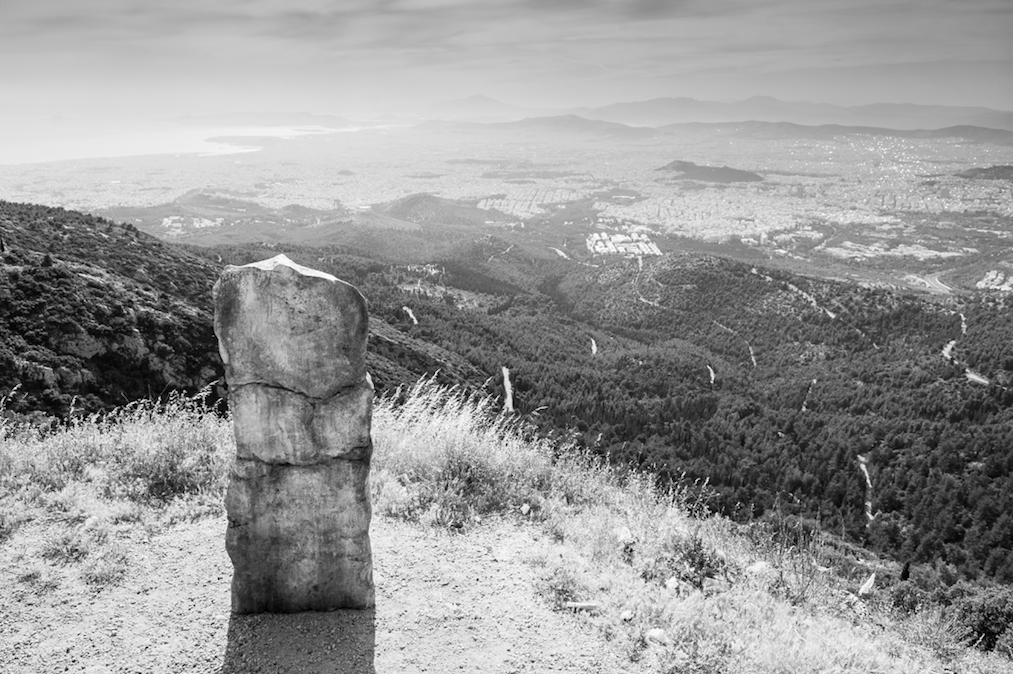




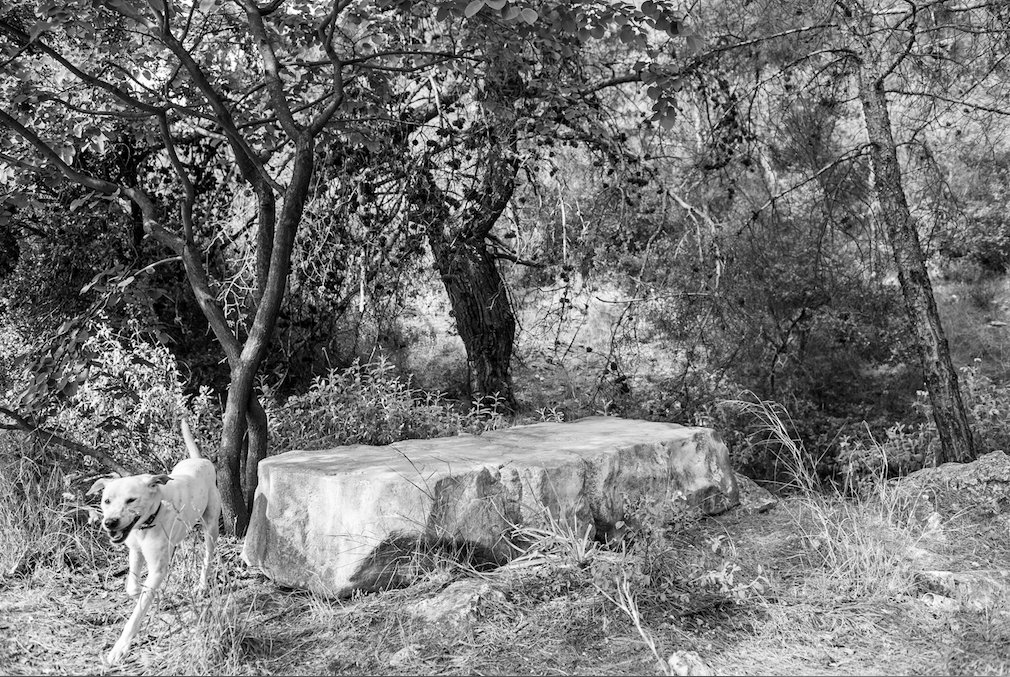
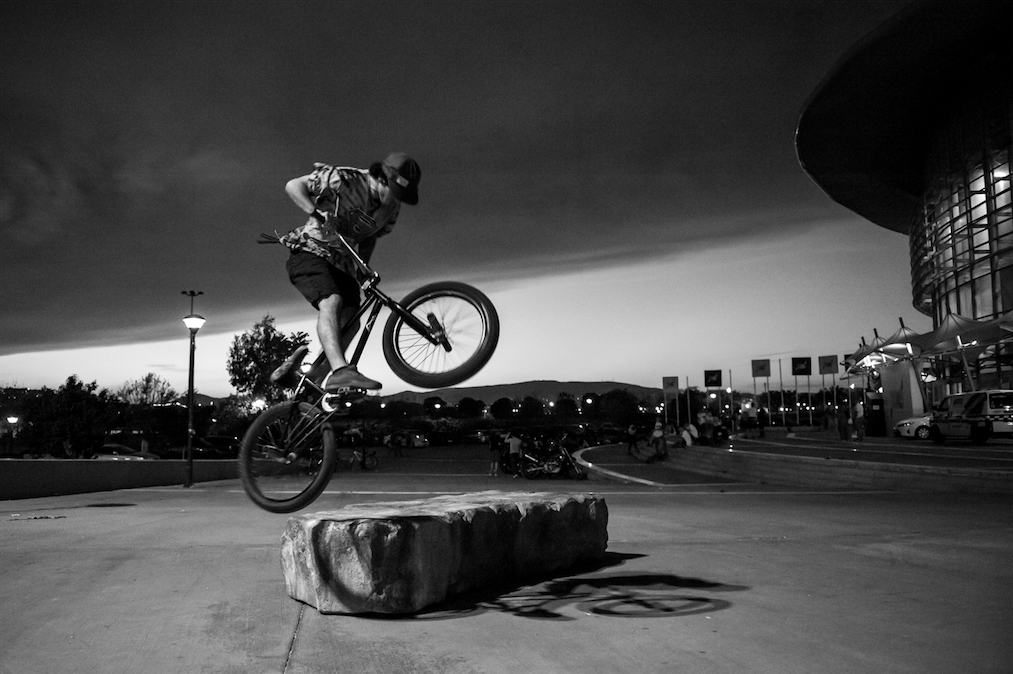
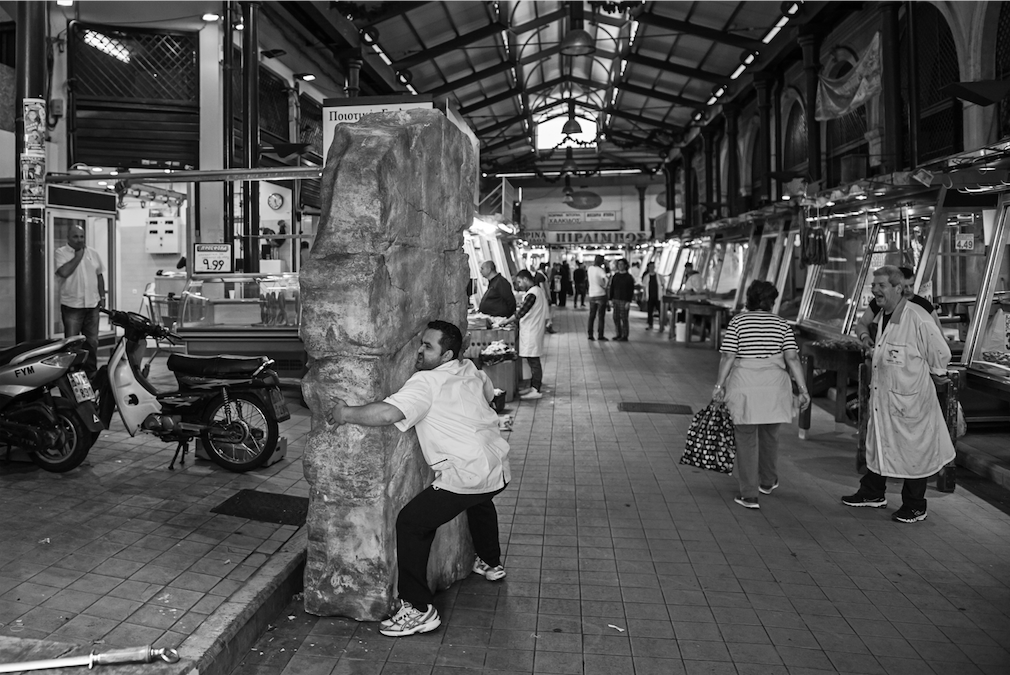

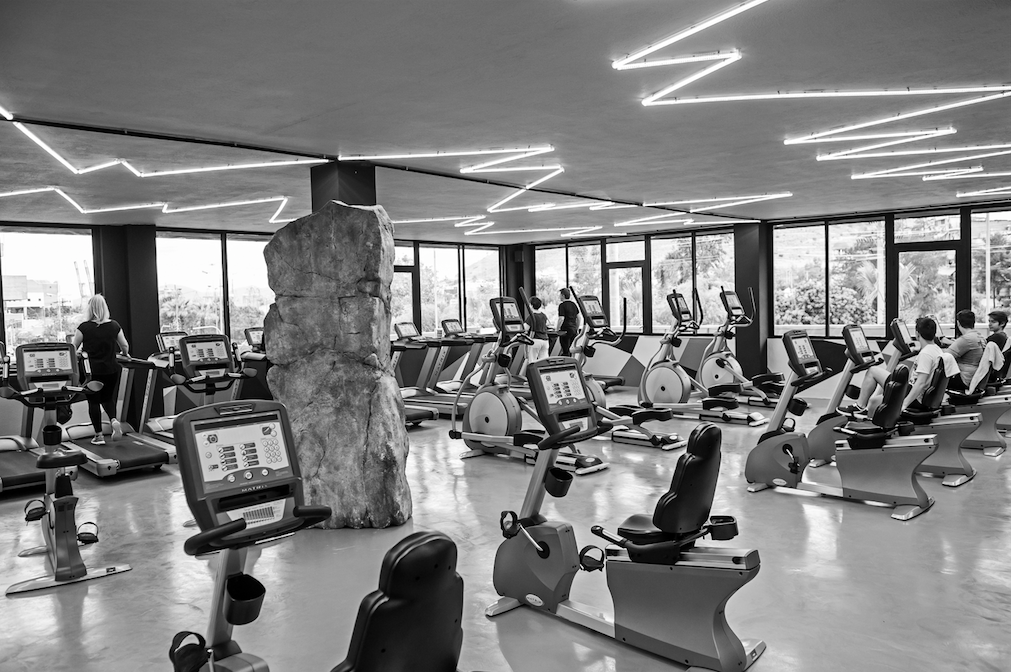



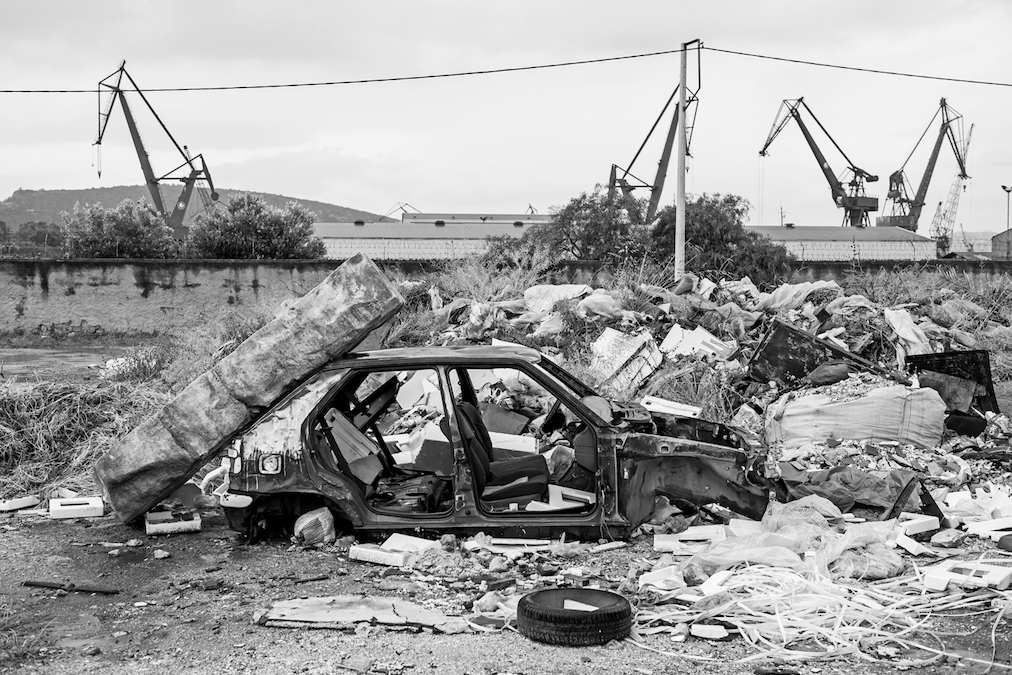


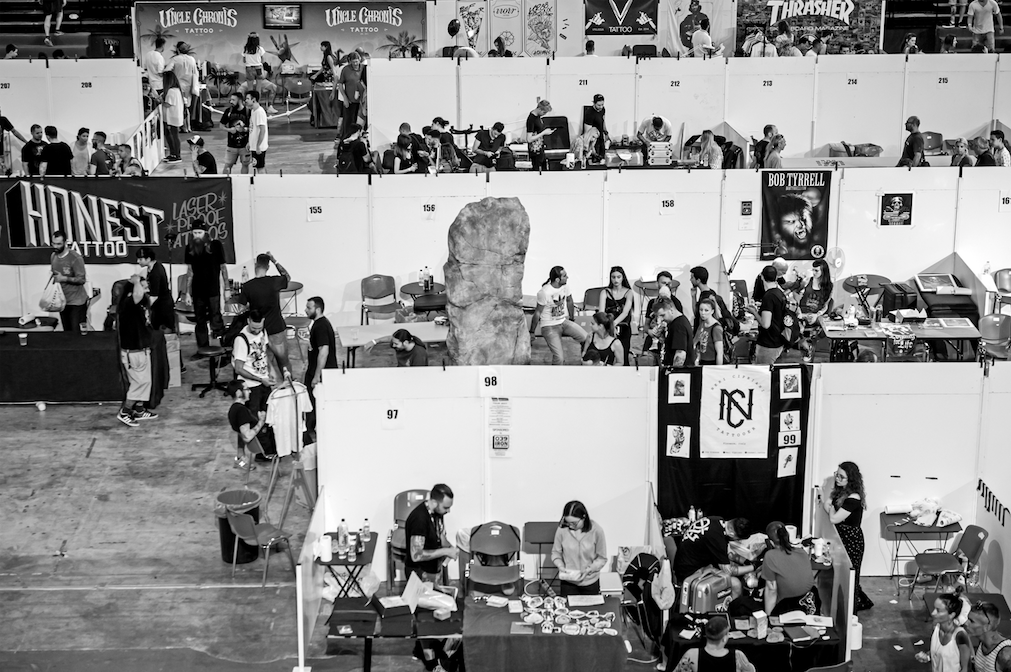
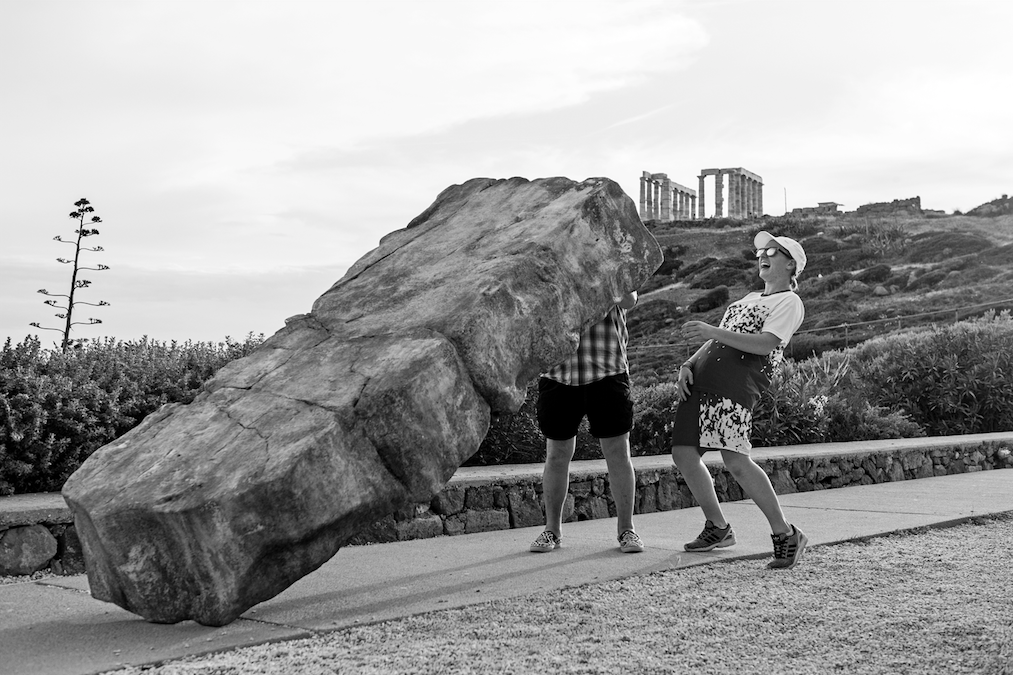
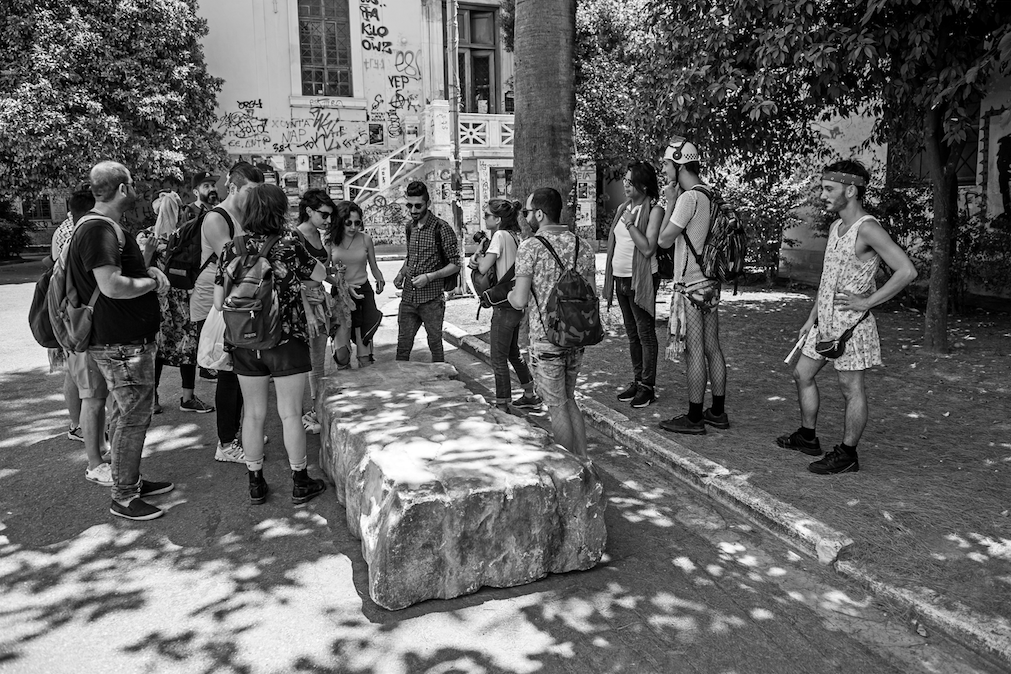




The «stone of oaths», a treasure of Greek archaeology, is moved from Athens to Kassel by more or less organized groups, collectives and individuals. In Kassel, the stone is exhibited at Documenta 14 together with photos of the route, a map of Las Rutas de la Guerra (Spain, 1938) and other documents. At the end of Documenta the stone was not buried in the nearby Thingplatz, as planned, but was auctioned on e-bay. (Download the press release here).
The video above is from the installation shown at the Neue Neue Gallerie in Kassel during the summer of 2017. This project was commissioned by Paul Preciado and Adam Szymczyk for Documenta 14. Photos by Karol Jarek.
VADEMECUM, by ROBERTO FRATINI
- The Thingspiel is the most extreme form of mass entertainment conceived by the Nazi regime.
- In order to carry out this mass theatre for the masses, the Nazi regime ordered the building of various types of Thingplatz throughout the Reich; these were spacious open areas surrounded by a semicircle of seating. This theatre is the inspiration for a kind of aesthetic very similar to that of the Olympic Games inauguration ceremonies of our times.
- The Nazi era Thingplatz on the one hand reintroduced the structure of the primitive Thingplatz where Germanic warriors of old used to gather, hold councils and celebrations (usually a forest clearing marked by a ring of stones) and on the other, the Greek amphitheatre.
- The various Thingplatz that survived de-Nazification can still be seen in Germany and are used for the celebration of mass events. Berlin’s Waldbühne, for example, with capacity for 21,000 people, is used to hold pop concerts.
- A Thingspiel is the theatrical event that takes place inside a Thingplatz. The people who become involved in these events are a collective that feel the call to personally experience a “lived epic” in which the myth of their national and/or racial identity is actively celebrated by means of choral movements, rhythmic organisation and massive group displays.
- In the Thingspiel, as a toxic form of participatory theatre, the audience are at the same time authors, performers and spectators of their own real fiction.
- The Thingspiel is a self-hypnotising device for groups that are prepared to stage their own mystical experience of a series of collective values that no longer need to be negotiated or discussed, as it is their active incarnation in the mass body of the crowd that justifies and ratifies them.
- The Thingspiel, which is where supposedly a community of people are given direct control of their own truth, is at the same time the most efficient device for producing the most fictional version, the most extreme manipulation – not to say extinction – of any effective control, of any critical conscience, of any dialectic presence. In short, it is the device with which the collective uses the most energy to celebrate being dispossessed of any possibility of becoming a real political subject.
- The aesthetics and semantics of the Thingspiel result in a wide spectrum of “performances of mass and identifying participation” whose most significant axis continues to be the enlisting of the collective body into manoeuvres of generalised consensus and unconditional acclaim. Nowadays, as part of the definitive unfolding of spectacular capitalism, the Nazi Thingspiel has become a pale prophecy of all the various kinds of “gymnastics of consensus” that the 21st century has provided for the consumer masses, all of them based on the strategic overlapping of the political, the cultural and the religious. Funeral ceremonies, re-enactments, collective stadium-based sports, cultural liturgies, the mysticism of fitness and the social networks are just some examples.
- It must be remembered that the root of the German word Thing is also the origin of the English thing, which generically describes a thing as a fundamental exchangeable object: the thing as the expression of an unspecified thingness; the thing as the physical and concrete example of something that can always be re-qualified, renamed, re-fetishised and, therefore, adored, celebrated, venerated, idolised. This syndrome – of an illusory materialism subject to displacement that exists only as the pretext for infinite mobilisations of the consensual collective – affects a broad range of possible objects: from the phallus (the object of specific cults before becoming the true axis of Fascist somatism) to the monument or simple goods. In this aspect, the materialism within the centre of the Thingspiel and all its postmodern copies is technically cadaverous.
- The result is that the movement that the collective makes in order to displace (physically and semantically) the object occupying the centre of the turbulence represented by the Thingspiel is always and only a false movement.
- This project by Roger Bernat/ FFF for Documenta 14 can be summed up as follows: a fake piece of marble (and therefore a fake piece of Greek archaeological heritage) is sent from Athens to Kassel. Diplomatic offering? Archaeological goods? Contemporary art piece? Monument? Corpse? Taxes due to the International Community? Typical produce? Forensic evidence? The existing or resulting collective agrees to physically manage the journey of the stone to Kassel – that is, of the journey that will turn an inexpressive copy of an inexpressive piece of stone into a magnet for cultural attention in the most important cultural event – and therefore also accepts managing this second aspect of its transmigration, which is symbolic, because it refers to the “fictions of valour” (cultural, religious, memorial, nostalgic, funereal, commercial, etc.) which the stone manages to take on thanks to the mobilisation of the collective around it.
- The project is therefore based on a fictional pact with the collective, which, by self-organising, organises the theatrification of the object it is moving or around which it moves; it accepts, in short, to celebrate around the stone a copy of the Thingspiel that is sufficiently conspiratorial to become a genuine anti-Thingspiel. If the former encouraged the blind participation of citizens in a fiction that was being passed off as true, the latter allows the dialectic creation of a truth that is known to be fictional. Thus creating around the “monolith” a multifaceted truth, a mysticism so dubious that it must inevitably be reconfigured as a shared (and therefore extraordinarily complex) form of political irony.
- Each of the participants will reconcile the specific dramaturgy of his or her own irony. Because the irony of their mobilisation depends on the values or positions that they wish to inscribe on the stone.
- For this inscription to be theatrical, it is vital to maintain intact the optimism particular to the Thingspiel: the stone is only the pretext of good intentions. The worst intentions, the most controversial programmes, the negativities, must be negotiated through the positive fiction constructed by the collective. The Thingspiel, it must be remembered, is a variation of the German traditional Festspiel: spectacle as liturgy, ceremony and celebration of the values of the people.
- Those responsible for the project see it as a dialectical questioning of the idea of success. They believe, in short, that within the framework of their participatory device, indifference, unwillingness to take part, even non-participation contribute to meaning just as much as the self-mobilisation of the “mobilised” collective. The failure of the project in itself or of itself would mean absolute success, poetically and ideologically, in relation to the project-for-Documenta. Failure is part of the state of grace that comprises the mission, the inscription, the official journey, the city walkabout, the Balkanic excursion, the flight, the party, the procession, the wandering, the drift, the banishment, the migration, the deportation, the misfortune of this fake Greek stone.
- The stone will not arrive in Kassel carrying truths or histories. It will arrive in Kassel carrying myths and tales, ghosts and lies. It is neither a document nor a monument: if anything, it is a nocument. Ghost ship, Trojan horse, poison candy. Undocumentable noxiousness.
- It would be a mistake to see the project as a genuine encounter between artists, collectives or individuals, all moved by a benevolent attachment to truth. If that were the case, Documenta would simply have to document the edifying advent of an exchange of truths. It is more accurate to see it as an unspecified festivity bringing together artists, collectives or individuals moved by a cynical fondness for revealing jokes, for half-genuine simulations, for the mot d’esprit and for impure truths that only produce illegitimate, unpresentable, useless, contradictory documents. The stone maintains a vague (or perhaps vagrant) relationship with the documentary poetry of the artistic and curatorial frame in which its physical and symbolic excursions take place.
- The structural risk that Documenta 14 took on when it re-created itself among the economic and social traumas of Greece was to back the ideology whereby the poor in everything else are rich in truths; and that these truths may be consumed in the morally and culturally balsamic form of a document, which is in fact the poorest type of art form of the poorest arts dedicated to poor artists: a confession turned into confessional art.
- We maintain the absolute right of the poor to lie.